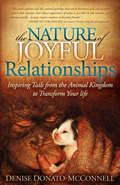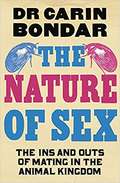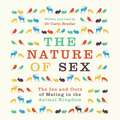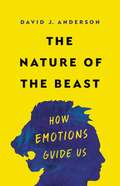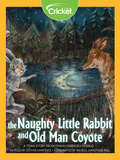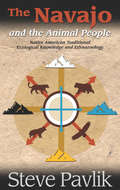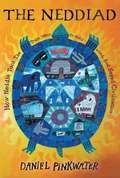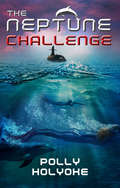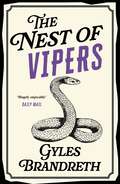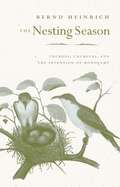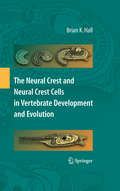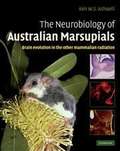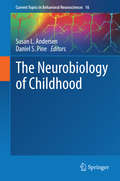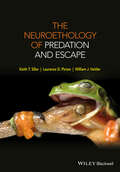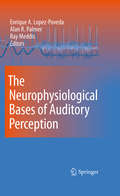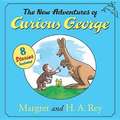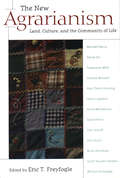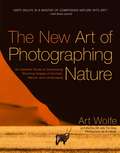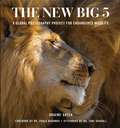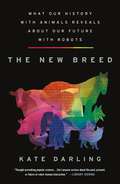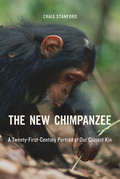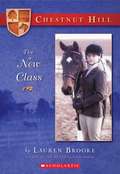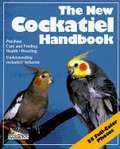- Table View
- List View
The Nature of Joyful Relationships: Inspiring Tails from the Animal Kingdom to Transform Your Life
by Denise Donato-McConnellHave you ever asked yourself any of these questions? Am I creating my relationships from a place of love and compassion? Isn't it just part of our animal nature to react with fear and anger? How do I change my perspective to create the healthy, joyful relationships I so desire? The author found answers in what may seem an unlikely group of teachers:
The Nature of Sex: The Ins and Outs of Mating in the Animal Kingdom
by Carin BondarThought about sex today? Of course you have! It's about the most natural thing any animal can do. But have you ever wondered how human sex compares to that of other beasts? It's far from merely inserting part A into slot B. The sex lives of our animal cousins are fiendishly difficult, infinitely varied and often violent. They involve razor-sharp penises, murderous cannibals and chemical warfare in an epic battle between the sexes.Join renowned biologist Dr Carin Bondar on a fascinating journey from puberty to old age across the entire animal kingdom - it will forever change your idle daydreams about the nature of sex.
The Nature of Sex: The Ins and Outs of Mating in the Animal Kingdom
by Dr Carin BondarThought about sex today? Of course you have! It's about the most natural thing any animal can do. But have you ever wondered how human sex compares to that of other beasts? It's far from merely inserting part A into slot B. The sex lives of our animal cousins are fiendishly difficult, infinitely varied and often violent. They involve razor-sharp penises, murderous cannibals and chemical warfare in an epic battle between the sexes.Join renowned biologist Dr Carin Bondar on a fascinating journey from puberty to old age across the entire animal kingdom - it will forever change your idle daydreams about the nature of sex.
The Nature of Sex: The Ins and Outs of Mating in the Animal Kingdom
by Dr Carin BondarNarrated by the author.Thought about sex today? Of course you have! It's about the most natural thing any animal can do. But have you ever wondered how human sex compares to that of other beasts? It's far from merely inserting part A into slot B. The sex lives of our animal cousins are fiendishly difficult, infinitely varied and often violent. They involve razor sharp penises, murderous cannibals and chemical warfare in an epic battle between the sexes.Like us, animals must first find the perfect partner. You think we have it tough? Try having to do it while being hunted down by predators, against a backdrop of unpredictable or life-threatening conditions. Then, sperm and egg must successfully meet. Can you imagine doing this when your partner is intent on killing you or when other disgruntled singles are determined to throw you off your game? The next task is to ensure that the resultant offspring reach sexual maturity in order to keep the cycle going. The myriad ways in which this is accomplished is ingenious.Join Carin Bondar on a fascinating journey from puberty to old age across the entire animal kingdom - it will forever change your idle daydreams about the nature of sex.(p) 2015 Orion Publishing Group
The Nature of the Beast: How Emotions Guide Us
by David J. AndersonA pioneering neuroscientist offers a new way of understanding how emotions drive behaviorDoes your dog get sad when you leave for the day? Does your cat purr because she loves you? Do bears attack when they&’re angry? You can&’t very well ask them. In fact, scientists haven&’t been able to reach a consensus on whether animals even have emotions like humans do, let alone how to study them. Yet studies of animal emotion are critical for understanding human emotion and mental illness. In The Nature of the Beast, pioneering neuroscientist David J. Anderson describes a new approach to solving this problem. He and his colleagues have figured out how to study the brain activity of animals as they navigate real-life scenarios, like fleeing a predator or competing for a mate. His research has revolutionized what we know about animal fear and aggression. Here, he explains what studying emotions and related internal brain states in animals can teach us about human behavior, offering new insights into why isolation makes us more aggressive, how sex and violence connect, and whether there&’s a link between aggression and mental illness. Full of fascinating stories, The Nature of the Beast reconceptualizes how the brain regulates emotions–and explains why we have them at all.
The Naughty Little Rabbit and Old Man Coyote
by Esther MartinezIn this traditional Tewa folktale, a coyote has a very bad day after a rabbit and a group of frogs outwit him. Stories of this mischievous rabbit have delighted generations of children in the Ohkay Owingeh Pueblo in New Mexico, where Tewa is their native language.
The Navajo and the Animal People
by Steve Pavlik Will TsosieThis text examines the traditional Navajo relationship to the natural world. Specifically, how the tribe once related to a category of animals they collectively referred to as the "ones who hunt." These animals, like Native Americans, were once viewed as impediments to progress requiring extermination.Steve Pavlik teaches Native American studies and Native environmental science at Northwest Indian College. He is the author or editor of four books including Destroying Dogma.
The Neddiad: How Neddie Took the Train, Went to Hollywood, and Saved Civilization
by Daniel PinkwaterWhen shoelace heir Neddie Wentworthstein and his family take the train from Chicago to Los Angeles in the 1940s, he winds up in possession of a valuable Indian turtle artifact whose owner is supposed to be able to prevent the impending destruction of the world, but he is not sure exactly how.
The Neptune Challenge (Neptune Project Ser.)
by Polly HolyokeDanger lurks beneath. . . . Genetically engineered to survive in the ocean, Nere and her friends are recovering from their treacherous journey to Safety Harbor, an undersea refuge founded by the scientists of the Neptune Project. But plenty of enemies prowl just outside the colony's boundaries, and when two of the children are kidnapped, Nere, her loyal dolphins, and the other Neptune kids must set out on an expedition even more perilous than their first. Tasked with infiltrating the kidnapper's high-tech undersea base, Nere soon discovers that rescuing the missing Neptune kids isn't all there is to her mission: the secret to saving the world's oceans is hidden somewhere deep inside this vast fortress, and she and her friends will have to risk everything to find it. With bloodthirsty shark mutates and savage kids roaming the corridors, will Nere and her companions find a way to save their friends, themselves, and their underwater world? The stakes couldn't be higher in this thrilling sequel to the award-winning The Neptune Project. Boy and Bear both love to explore the outdoors. There are so many neat things to see, and so many strange things to find. These explorers are prepared for anything . . . except each other! When Bear and Boy meet in the woods, they're scared at first. Really scared. But soon these kings of the wild realize that no mountain is too big to conquer if you have a friend to climb it by your side. Praise for The Neptune Project 2014-2015 Texas Bluebonnet Master List Maryland Black-Eyed Susan Book Award nominee Bank Street Best Children's Books of the Year, 2014 "Holyoke keeps her prose well-pitched to her audience . . . this suspenseful, undersea dystopia should keep middle schoolers hooked." --Kirkus Reviews "The book revels in the beauty of the underwater world and the creatures that inhabit it. The relationship between the teenagers and the dolphins -- who actually become characters themselves-is especially well crafted. The Neptune Project will attract male and female readers." -- VOYA
The Nest of Vipers: The Victorian Murder Mystery Series: 4 (The Victorian Murder Mystery Series #4)
by Gyles Brandreth'A ripping yarn . . . A wonderful period murder mystery' Reader review ⭐⭐⭐⭐⭐'What a whizbang, intelligent fun read! . . . A delight' Reader review ⭐⭐⭐⭐⭐Society truly can be murder . . .1890: Famous author Oscar Wilde is a guest at a glamorous, high-society party hosted by the Duke and Duchess of Albemarle - even the Prince of Wales has turned up for the festivities. But the evening ends in tragedy when the Duchess is found murdered.No one apart from the invited guests have entered the house; no one has left. And it is only Wilde and his friend Arthur Conan Doyle, author of Sherlock Holmes, who have seen the puncture marks on the Duchess's neck . . . Desperate to avoid another scandal, the Prince appeals to the two writers to investigate the crime and protect the reputation of the royal family.But as they investigate further, the eerie details of the case threaten to pull them into a darker plot than they could have ever imagined . . .A wonderfully witty and gripping cosy historical mystery that will send tingles up your spine. Perfect for fans of Sherlock Holmes, Agatha Christie and Richard Osman.Readers are gripped by The Nest of Vipers:'A real rollicking read . . . Entertaining on so many levels' Reader review ⭐⭐⭐⭐⭐'The fact that I read this book cover to cover in only a couple of sittings, tells you just how much I enjoyed every moment . . . It has my highest recommendation' Reader review ⭐⭐⭐⭐⭐'Another cracking Oscar Wilde mystery . . . A fast-moving novel and one I found hard to put down. Highly recommended' Reader review ⭐⭐⭐⭐⭐'This historical mystery is head and shoulders above most of the competition in its field, elegantly written and paced . . . I'm hooked' Reader review ⭐⭐⭐⭐⭐'Very funny, great yarn. Love the historical mystery incorporating' Reader review ⭐⭐⭐⭐⭐
The Nesting Season: Cuckoos, Cuckolds, and the Invention of Monogamy
by Bernd HeinrichWhy are the eggs of the marsh wren deep brown, the winter wren's nearly white, and the gray catbird's a brilliant blue? And what in the DNA of a penduline tit makes the male weave a domed nest of fibers and the female line it with feathers, while the bird-of-paradise male builds no nest at all, and his bower-bird counterpart constructs an elaborate dwelling? These are typical questions that Bernd Heinrich pursues in the engaging style we've come to expect from him supplemented here with his own stunning photographs and original watercolors. One of the world's great naturalists and nature writers, Heinrich shows us how the sensual beauty of birds can open our eyes to a hidden evolutionary process. Nesting, as Heinrich explores it here, encompasses what fascinates us most about birds from their delightful songs and spectacular displays to their varied eggs and colorful plumage; from their sex roles and mating rituals to nest parasitism, infanticide, and predation. What moves birds to mate and parent their young in so many different ways is what interests Heinrich and his insights into the nesting behavior of birds has more than a little to say about our own.
The Neural Crest and Neural Crest Cells in Vertebrate Development and Evolution
by Brian K. HallA presentation of all aspects of neural crest cell origins (embryological and evolutionary) development and evolution; neural crest cell behavior (migration) and anomalies (neurocristopathies and birth defects) that arise from defective neural crest development. The treatment of development will include discussions of cellular, molecular and genetic aspects of the differentiation and morphogenesis of neural crest cells and structures derived from neural crest cells. The origins of the neural crest in embryology will be discussed using the recent information on the molecular basis of the specification of the neural crest. Also presented are the advances in our understanding of the evolution of jaws from studies on lampreys and of the neural crest from studies on ascidians and amphioxus.
The Neurobiology of Australian Marsupials
by Ken W. S. AshwellAustralian marsupials represent a parallel adaptive radiation to that seen among placental mammals. This great natural experiment has produced a striking array of mammals with structural and behavioural features echoing those seen among primates, rodents, carnivores, edentates and ungulates elsewhere in the world. Many of these adaptations involve profound evolutionary changes in the nervous system, and occurred in isolation from those unfolding among placental mammals. Ashwell provides the first comprehensive review of the scientific literature on the structure and function of the nervous system of Australian marsupials. The book also includes the first comprehensive delineated atlases of brain structure in a representative diprotodont marsupial (the tammar wallaby) and a representative polyprotodont marsupial (the stripe-faced dunnart). For those interested in brain development, the book also provides the first comprehensive delineated atlas of brain development in a diprotodont marsupial (the tammar wallaby) during the critical first 4 weeks of pouch life.
The Neurobiology of Childhood (Current Topics in Behavioral Neurosciences #16)
by Susan L. Andersen and Daniel S. PineDuring the past years there has been rapid progress in the understanding of how early life stress impacts psychopathology in children. The first two parts of this book present the basic principles of brain development and describe the most important neuronal systems. This includes systems involved in emotion processing, cognitive control, and social processes. These first two general sections are followed by an overview about recent research on various neuronal and psychiatric disorders, where environmental exposures and altered brain development play an important role: sleep, autism, ADHD and other developmental forms of psychopathology.
The Neuroethology of Predation and Escape
by Keith T. Sillar William J. Heitler Laurence D. PictonThe forces of natural selection have been a primary driver in the evolution of adaptive animal behaviours. On the one hand animals must evade predation in order to survive and pass on their genes; on other hand, and for the same underlying reasons, animals must also be capable of successfully capturing prey. This situation has led to an evolutionary arms race in which predator and prey are locked in the battle to survive. A common strategy in each situation is to enhance the speed of response, resulting in the evolution of neural, muscular and biomechanical designs that produce supremely fast and eye-catching behavioral responses. The aim of this book is to illuminate the design principles of escape and predatory behaviours using a series of case histories from different animal groups and to emphasize the convergent evolution of neural circuitry that optimizes the chances of survival. Using these case histories the authors describe sensory mechanisms that aid prey and predator detection, central neural circuit designs that increase speed of response and neuromuscular and biomechanical properties that aid the performance of escape and predatory movements.
The Neurophysiological Bases of Auditory Perception
by Ray Meddis Enrique Lopez-Poveda Alan R. PalmerThe International Symposium on Hearing is a triennial, highly-prestigious event where world-class scientists present and discuss the most recent advances in the field of hearing research. The symposium focuses on the relationship between auditory physiology, psychoacoustics, and computational modeling. Presented papers range from basic to applied research, and are published in book format. The books from past editions have a large demand by neuroscientists, otolaryngologists, psychologists, and artificial intelligence researchers. This meeting is highly special in that every paper is a plenary session given by invitation by a key, world-class auditory scientist. There are no poster sessions. The editors will have to choose the best 60 papers from approximately 80 submitted abstracts. Priority will be given to hot topics and to papers showing significant advances (this is almost guaranteed, anyhow, by the quality of the speakers). Papers will be submitted by invitation only and invitations will be sent only to the most-significant auditory scientists at present. Furthermore, published papers can be regarded as peer-reviewed because they will be accompanied (in print) by a full discussion between the authors and other conference attendants. This format is identical to that of preceding editions of this symposium and has proven highly successful. A full list of past conference books is given below. We will not know the list of chapters until approximately November 2008, that is 6 months before the conference (May 2009). You can get an idea of the type and format of the chapters by having a look at the books for the last two symposium editions, which were published by Springer.
The New Adventures of Curious George
by Margret ReyThis collection includes eight full-length stories including Curious George Goes to a Chocolate Factory, Curious George and the Puppies, Curious George Makes Pancakes, Curious George Feeds the Animals, Curious George Goes to a Movie, Curious George and the Hot Air Balloon, Curious George in the Snow, and Curious George’s Dream.
The New Agrarianism: Land, Culture, and the Community of Life
by Eric T. FreyfogleThe engaging writings gathered in this new book explore an important but little-publicized movement in American culture -- the marked resurgence of agrarian practices and values in rural areas, suburbs, and even cities. It is a movement that in widely varied ways is attempting to strengthen society's roots in the land while bringing greater health to families, neighborhoods, and communities. The New Agrarianism vividly displays the movement's breadth and vigor, with selections by such award-winning writers as Wendell Berry, William Kittredge, Stephanie Mills, David Orr, Scott Russell Sanders, and Donald Worster. As editor Eric Freyfogle observes in his introduction, agrarianism is properly conceived in broad terms, as reaching beyond food production to include a wide constellation of ideals, loyalties, sentiments, and hopes. It is a temperament and a moral orientation as well as a suite of diverse economic practices -- all based on the insistent truth that people everywhere are part of the land community, as dependent as other life on its fertility and just as shaped by its mysteries and possibilities. The writings included here have been chosen for their engaging narratives as well as their depiction of the New Agrarianism's broad scope. Many of the selections illustrate agrarian practitioners in action, while other selections offer pointed critiques of contemporary American culture and its market-driven, resource-depleting competitiveness. Together, they reveal what Freyfogle identifies as the heart and soul of the New Agrarianism: its yearning to regain society's connections to the land and its quest to help craft a more land-based and enduring set of shared values. The New Agrarianism offers a compelling vision of this hopeful new way of living. It is an essential book for social critics, community activists, organic gardeners, conservationists, and all those seeking to forge sustaining ties with the entire community of life.
The New Art of Photographing Nature: An Updated Guide to Composing Stunning Images of Animals, Nature, and Landscapes
by Art Wolfe Martha HillA new spin on the classic guide to composing stunning images of nature and wildlife What is the difference between a good picture and a great one? In this fully revised edition of the classic bestseller The Art of Photographing Nature, master photographer Art Wolfe and former Audubon photo editor Martha Hill team up to explain the art of composing images of enduring beauty. Against a backdrop of more than 250 photographs of nature, wildlife, and landscapes, they share insights and advice about what works and what doesn't, and how small changes can take an image from ordinary to extraordinary. Throughout, all-new tips from digital imaging expert Tim Grey show readers how to make the most of digital technology, whether by choosing the right color space, understanding sensor size, or removing distracting elements in post-processing. The result is an invaluable collection of expert advice updated for the modern age.
The New Big 5
by Graeme GreeneThe world&’s wildlife is in crisis, and the next ten years are critical.The New Big 5 brings together more than 145 of the world&’s greatest wildlife photographers, conservationists, and advocates in a mission to not only celebrate the natural beauty of the animal world, but to raise awareness of the crucial issues facing these magnificent creatures. Until recently, the Big Five referred to the five big-game animals that were most difficult for colonial hunters to shoot and kill. Wildlife photographer Graeme Green&’s The New Big 5 Project set about to reclaim that gruesome, antiquated term by asking people around the world to vote on the five endangered animals they would most want to shoot—with a camera. More than fifty thousand people voted, and the New Big 5 list of Wildlife Photography was born. What are the New Big 5? Elephants Gorillas Tigers Lions Polar Bears With 226 stunning photos and informative essays from the world&’s greatest wildlife advocates, this one-of-a-kind book inspires and raises awareness about the New Big 5, and our wildlife world. FEATURES MANY OTHER ENDANGERED SPECIES: An extensive chapter is devoted to endangered species, such as rhinos, cheetahs, lemurs, frogs, vultures, sharks, whales, and turtles. INCREDIBLE CREATIVE PHOTOGRAPHY: Majestic portraits, animals in their habitat, and examples of natural behavior from more than 145 renowned wildlife photographers, including Ami Vitale, Marsel van Oosten, Paul Nicklen, Steve McCurry, Karine Aigner, Brian Skerry, Lucas Bustamante, Beverly Joubert, Clement Kiragu, Thomas Mangelsen, Paul Hilton, Suzi Eszterhas, Sascha Fonseca, Cristina Mittermeier, Frans Lanting, Marina Cano, Gael R. Vande Weghe, Daisy Gilardini, Steve Winter, Qiang Zhang, Art Wolfe, Dhritiman Mukherjee, Will Burrard-Lucas, David Lloyd, Vicki Jauron, Sergey Gorshkov, and Thomas Vijayan. ENGAGING ESSAYS from leading conservationists, including Dr. Jane Goodall, Dr. Paula Kahumbu (Wildlife Direct), Dr. Tara Stoinski (CEO, Dian Fossey Gorilla Fund), Krista Wright (Executive Director, Polar Bears International), Dr. Anish Andheria (CEO, Wildlife Conservation Trust), Dr. Moreangels Mbizah (Executive Director, Wildlife Conservation Action), Dominique Gonçalves (Manager, Elephant Ecology Project at Gorongosa National Park), and Wes Sechrest (CEO, Re:wild). &“I hope the photos in this The New Big 5 book will lead people into the wonderful worlds of these iconic species - elephants, polar bears, gorillas, tigers and lions - and encourage them to explore the lives of so many other fascinating creatures, many of which are also endangered. Then, perhaps, other people will become involved in helping to create a world where wildlife can flourish for future generations to enjoy. I believe we have a window of time during which we can start to heal some of the harm we have inflicted on the natural world and slow down the heating of the planet. But only if we get together and take action now.&” - Dr. Jane Goodall
The New Breed: What Our History with Animals Reveals about Our Future with Robots
by Kate DarlingFor readers of The Second Machine Age or The Soul of an Octopus, a bold, exciting exploration of how building diverse kinds of relationships with robots—inspired by how we interact with animals—could be the key to making our future with robotic technology work.There has been a lot of ink devoted to discussions of how robots will replace us and take our jobs. But MIT Media Lab researcher and technology policy expert Kate Darling argues just the opposite, and that treating robots with a bit of humanity, more like the way we treat animals, will actually serve us better. From a social, legal, and ethical perspective, she shows that our current ways of thinking don’t leave room for the robot technology that is soon to become part of our everyday routines. Robots are likely to supplement—rather than replace—our own skills and relationships. So if we consider our history of incorporating animals into our work, transportation, military, and even families, we actually have a solid basis for how to contend with this future. A deeply original analysis of our technological future and the ethical dilemmas that await us, The New Breed explains how the treatment of machines can reveal a new understanding of our own history, our own systems and how we relate—not just to non-humans, but also to each other.
The New Car (Fountas & Pinnell Classroom, Guided Reading)
by Dominic Catalano Annie O'BrienNIMAC-sourced textbook. Zoom! Fox has a new car, and it's fast, fast, fast!
The New Chimpanzee: A Twenty-First-Century Portrait of Our Closest Kin
by Craig StanfordRecent discoveries about wild chimpanzees have dramatically reshaped our understanding of these great apes and their kinship with humans. We now know that chimpanzees not only have genomes similar to our own but also plot political coups, wage wars over territory, pass on cultural traditions to younger generations, and ruthlessly strategize for resources, including sexual partners. In The New Chimpanzee, Craig Stanford challenges us to let apes guide our inquiry into what it means to be human. With wit and lucidity, Stanford explains what the past two decades of chimpanzee field research has taught us about the origins of human social behavior, the nature of aggression and communication, and the divergence of humans and apes from a common ancestor. Drawing on his extensive observations of chimpanzee behavior and social dynamics, Stanford adds to our knowledge of chimpanzees’ political intelligence, sexual power plays, violent ambition, cultural diversity, and adaptability. The New Chimpanzee portrays a complex and even more humanlike ape than the one Jane Goodall popularized more than a half century ago. It also sounds an urgent call for the protection of our nearest relatives at a moment when their survival is at risk.
The New Class (Chestnut Hill #1)
by Lauren BrookeWelcome to Chestnut Hill, a prestigious boarding school with a rich tradition of academics, horses, and rivalry. This year, five girls from different backgrounds will challenge the Chestnut Hill stereotype. There's witty, spunky Dylan; secretive Malory; western tomboy Lani; Honey, the soft-spoken Brit; and polished New Yorker Razina. None is prepared for the social or riding rigors, and they all doubt they will fit in -- certainly not if queen bee Lynsey and her clique have any say. But if this unlikely fivesome can band together, they may prove themselves the true stars of Chestnut Hill.
The New Cockatiel Handbook
by Matthew M. VriendsBarron's Pet Handbooks provide information on health care, proper feeding and housing, training and other animal-care details of interest to pet owners. All books are filled with handsome full-color photos, and instructive line art. Cockatiels - parrot-related birds that originated in Australia - come in a variety of color mutations. This handbook gives detailed purchase advice, considerations related to caging, proper nutrition, grooming, health care, and keeping the bird safe from household hazards.
